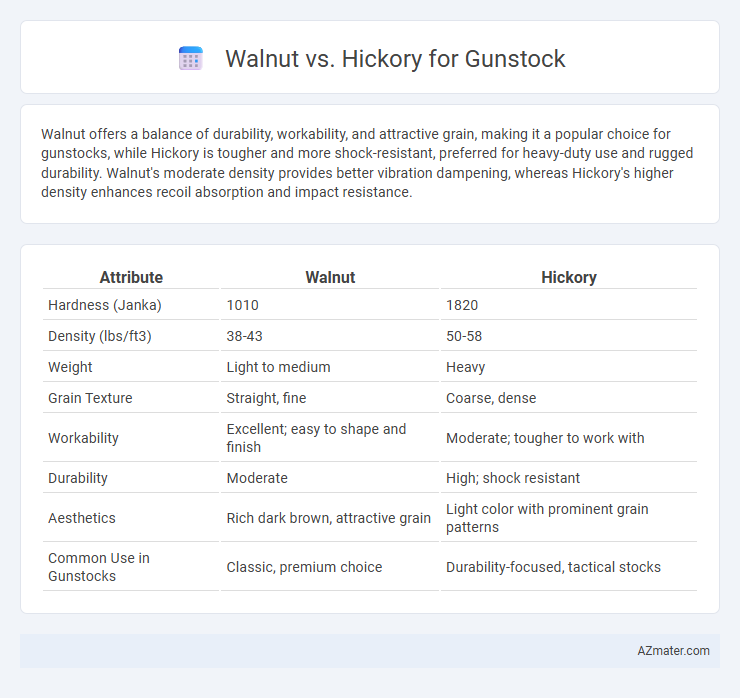Walnut offers a balance of durability, workability, and attractive grain, making it a popular choice for gunstocks, while Hickory is tougher and more shock-resistant, preferred for heavy-duty use and rugged durability. Walnut's moderate density provides better vibration dampening, whereas Hickory's higher density enhances recoil absorption and impact resistance.
Table of Comparison
| Attribute | Walnut | Hickory |
|---|---|---|
| Hardness (Janka) | 1010 | 1820 |
| Density (lbs/ft3) | 38-43 | 50-58 |
| Weight | Light to medium | Heavy |
| Grain Texture | Straight, fine | Coarse, dense |
| Workability | Excellent; easy to shape and finish | Moderate; tougher to work with |
| Durability | Moderate | High; shock resistant |
| Aesthetics | Rich dark brown, attractive grain | Light color with prominent grain patterns |
| Common Use in Gunstocks | Classic, premium choice | Durability-focused, tactical stocks |
Introduction to Walnut and Hickory Gunstocks
Walnut gunstocks are prized for their rich color, fine grain, and natural durability, making them a popular choice among firearm enthusiasts seeking both aesthetics and performance. Hickory gunstocks, known for their exceptional strength and shock resistance, provide rugged reliability and are favored in heavy-use hunting rifles. Both woods offer unique advantages, with walnut delivering elegance and hickory excelling in toughness and impact absorption.
Wood Grain and Appearance Comparison
Walnut features a straight, fine grain with occasional curly or wavy patterns that provide a smooth, uniform appearance ideal for gunstocks. Hickory displays a more pronounced, coarse grain with distinct color contrasts between its light sapwood and darker heartwood, resulting in a rugged, bold look. The choice between Walnut and Hickory often hinges on preference for Walnut's refined elegance versus Hickory's striking, rustic aesthetic.
Durability and Strength: Walnut vs Hickory
Walnut offers a balanced combination of moderate durability and strength, making it a popular choice for gunstocks with good shock absorption and ease of carving. Hickory, known for its exceptional toughness and impact resistance, provides superior durability and strength, ideal for heavy-duty use and withstanding recoil. Choosing between walnut and hickory depends on the desired balance between weight, workability, and ruggedness in gunstock construction.
Weight Differences in Gunstock Performance
Walnut gunstocks are generally lighter with a density around 38-42 pounds per cubic foot, offering enhanced maneuverability and reduced fatigue during extended shooting sessions. Hickory, denser at approximately 50-55 pounds per cubic foot, provides superior strength and recoil absorption, making it suitable for heavy-caliber rifles. The weight difference significantly impacts gunstock performance, where walnut favors ease of handling and hickory excels in durability and shock resistance.
Workability for Gunsmiths
Walnut is widely favored by gunsmiths for gunstocks due to its excellent workability, combining a balance of hardness and flexibility that allows for precise carving and shaping without splintering. Hickory, though extremely durable and tough, presents more challenges in workability because of its dense grain and hardness, often requiring specialized tools and increased effort to achieve fine detailing. The superior machinability of walnut makes it the preferred choice for intricate gunstock designs, while hickory is chosen primarily for rugged, impact-resistant applications.
Recoil Absorption and Shooter Comfort
Hickory is renowned for its exceptional recoil absorption properties, making it a top choice for gunstocks where managing strong recoil is critical. Walnut, while offering moderate recoil absorption, excels in shooter comfort due to its natural grain texture and balanced weight, reducing fatigue during extended use. Both woods provide durable options, but hickory's superior impact resistance often results in a smoother shooting experience for high-caliber firearms.
Long-Term Maintenance and Care
Walnut gunstocks require regular oiling every 6 to 12 months to maintain moisture balance and prevent cracking, making them easier to maintain long-term due to their natural resistance to warping. Hickory gunstocks, while tougher and more durable under heavy use, demand more frequent inspections and occasional sanding to manage their higher density and susceptibility to surface wear. Both woods benefit from proper cleaning and storage in stable humidity conditions to prolong their lifespan and preserve finish quality.
Cost and Availability of Materials
Walnut gunstocks generally cost more due to their widespread demand and premium quality, while hickory offers a more affordable alternative often favored for its toughness and shock resistance. Availability of walnut can be limited and pricier because of regulated harvesting and slower growth rates, whereas hickory is more abundant and easier to source from North American forests. Choosing between walnut and hickory depends largely on budget considerations and local material accessibility, with walnut serving as a classic, high-end choice and hickory providing a durable option at a lower price point.
Historical Preferences in Gunstock Wood
Walnut has historically been the preferred wood for gunstocks due to its ideal balance of strength, workability, and aesthetic grain patterns, making it a staple material since the 18th century. Hickory gained popularity in the 19th and early 20th centuries, especially for military and hunting rifles, prized for its exceptional hardness and shock resistance. Collectors and craftsmen often value walnut for traditional elegance, while hickory is favored for durability in rugged conditions.
Final Verdict: Which is Better for Your Gunstock?
Hickory offers superior strength and shock resistance, making it ideal for heavy recoil and durability in gunstocks, while walnut provides a balance of strength and aesthetic appeal with its fine grain and rich color. Walnut is favored for its smooth working qualities and traditional look, suitable for collectors and hunters valuing appearance alongside function. Choosing between hickory and walnut depends on prioritizing either toughness and resilience or beauty and craftsmanship in your gunstock.

Infographic: Walnut vs Hickory for Gunstock
 azmater.com
azmater.com